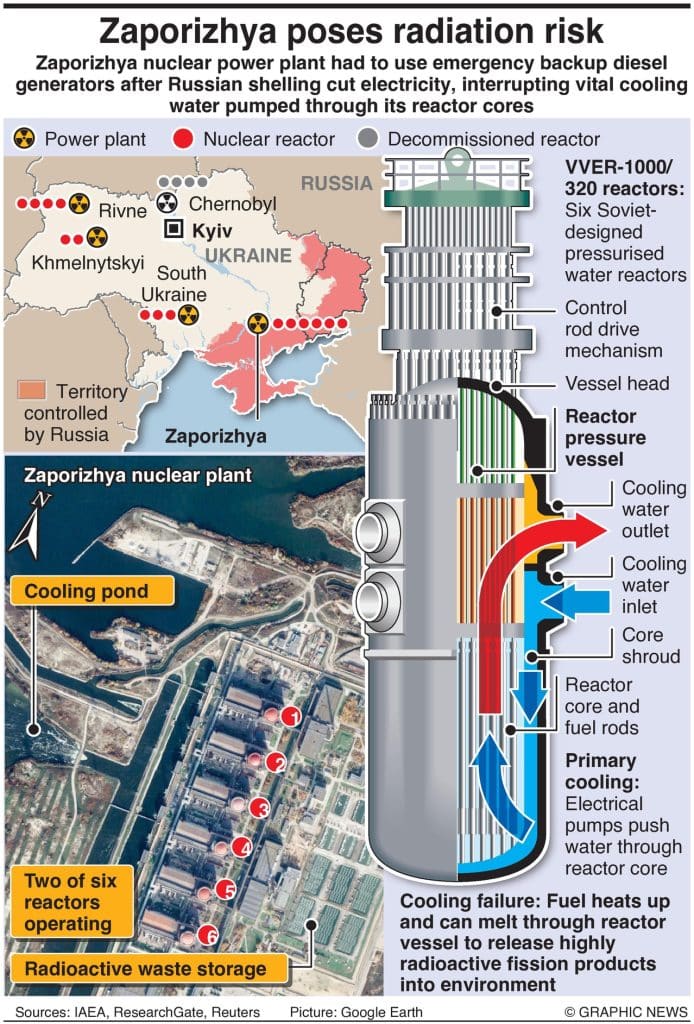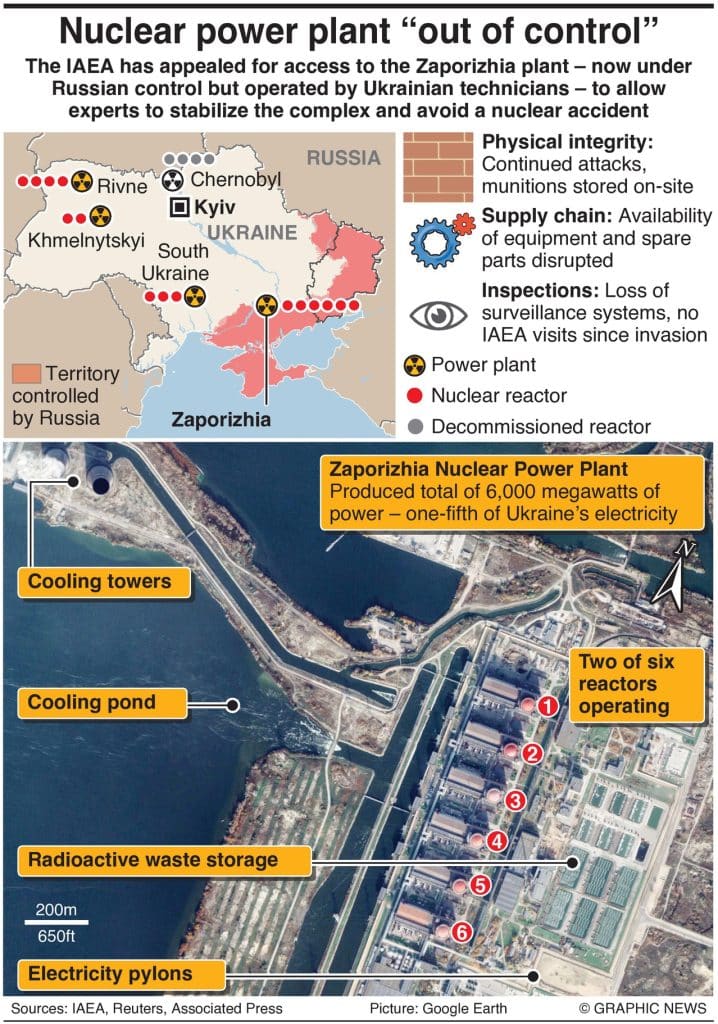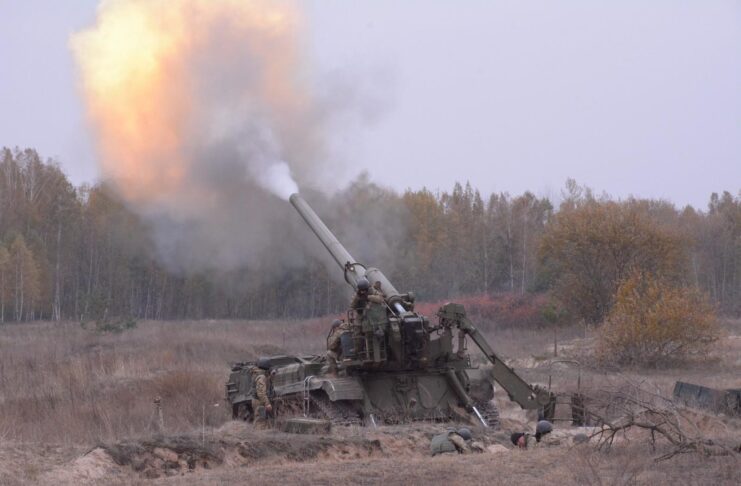The International Atomic Energy Agency (IAEA), an independent organization that reports to the UN, Tuesday issued a report on the Russian-held Zaporizhzhia Nuclear Power Station (ZNPP) in Ukraine, Europe's largest.
Months of fighting near ZNPP have created extensive damage and an “unsustainable” situation going forward, the UN's nuclear watchdog agency said Tuesday.
The report warns of the possibility of a nuclear emergency due to continued shelling and other military activity and strongly advises that an agreement be reached to create a demilitarized ‘security zone' around the plant to protect it from potentially catastrophic damage.
The report follows a daring and unprecedented inspection by IAEA inspectors and its director general, Rafael Grossi, who crossed the front lines in a war zone under shelling to reach the plant.
The inspectors confirmed the presence of Russian soldiers and military equipment at the plant, including army vehicles.
In his statement Grossi said:
We are playing with fire and something very, very catastrophic could take place. This is why in our report, we are proposing the establishment of a nuclear safety and security protection zone limited to the perimeter and the plant itself.
The ZNPP has been held by Russian forces since early March, but its Ukrainian staff is continuing to operate the plant.
However, Britain's ambassador to the UN, Dame Barbara Woodward, told the security council the Zaporizhzhia staff were “no longer workers, but hostages being held at gunpoint.”
As the IAEA noted:
Last week, after months of efforts, Director General Grossi established an IAEA presence at Europe's largest nuclear power plant when he led a team of experts across the frontline to the facility. Two IAEA experts remain at the site, providing independent and objective monitoring and assessments of the situation there.
Based on information gained on the ground at the site by the recently arrived IAEA inspectors, the agency reported that:
Renewed shelling has damaged a back-up power line between Ukraine's Zaporizhzhya Nuclear Power Plant (ZNPP) and a nearby thermal power station, further underlining significant nuclear safety risks at the facility…

The agency provided seven recommendations to secure the ZNPP and prevent a major nuclear emergency. These recommendations are summarized here by Reuters.
The most significant recommendation, according to UN Secretary-General António Guterres, is to come to an agreement that commits Russian forces to withdraw and Ukrainian forces not to move in.
The Guardian reports that Ukraine is willing to accept the IAEA recommendation, but the Russians have not responded to this proposal.
Ukraine's president, Volodymyr Zelenskiy, offered qualified support for Grossi's proposal to create a demilitarised zone around the plant and asked for more detail on the plan.
“If the content of this proposal is to demilitarise the territory of the nuclear power plant – and this is logical, as it was the Russian military presence that put the Zaporizhzhia plant on the brink of a radiation disaster – then we can support such a demilitarised protection zone,” he said.
The Russian ambassador to the UN, Vasily Nebenzya, blamed recent shelling of the plant on Ukraine and portrayed Russian forces as protecting the plant. He did not respond to the call for a security zone, a proposal Moscow has so far rejected. Nebenzya said he had not had time to read the IAEA report.
See the graphics below for additional background on the plant and risks created by the Russian invasion from earlier news reports prior to the IAEA inspectors arriving at ZNPP.


It should be noted that the world's worst civilian nuclear disaster occurred in 1986 at Chernobyl, Ukraine. It also involved a Soviet-built nuclear plant. The second worst was the 2011 Fukushima nuclear disaster in Japan, which followed a massive earthquake and tsunami.
In a situation similar to ZNPP now, the meltdown at Fukushima occurred after the facility was disconnected from the external grid and a tsunami triggered damage to the reactors there.
Both were the only ones ever rated at seven on the International Nuclear and Radiological Event Scale (INES) — the maximum severity.
However, due in part to the prompt response and transparency by Japanese authorities, the Fukushima incident was significantly less damaging to the surrounding areas than the Chernobyl meltdown.
The opinions expressed in this article are those of the author and do not necessarily reflect the positions of American Liberty News.
READ NEXT: China Looks for Naval Base in Nicaragua, Like Soviets Did Before Them >>



May the good Lord pick up that entire power plant and drop it on Moscow!
A few well placed tactical nukes would work just as well. Somebody must know where Putin is hiding.
The reason that this is happening is that Russia is trying to control all of the power that goes to Europe and is trying to send it to Russia. Russia has set up and army base with artillery that is used against the Ukrainians because they know that Ukraine cannot fire back at them. The UN has got to intervene by force like they did in Korea and send in peacekeepers to set up a DMZ around it. Or the Ukrainian Army can continue their offensive and cut all supply lines to the area which is the option that I think will happen. Russian soldiers are running away from most combat areas now.